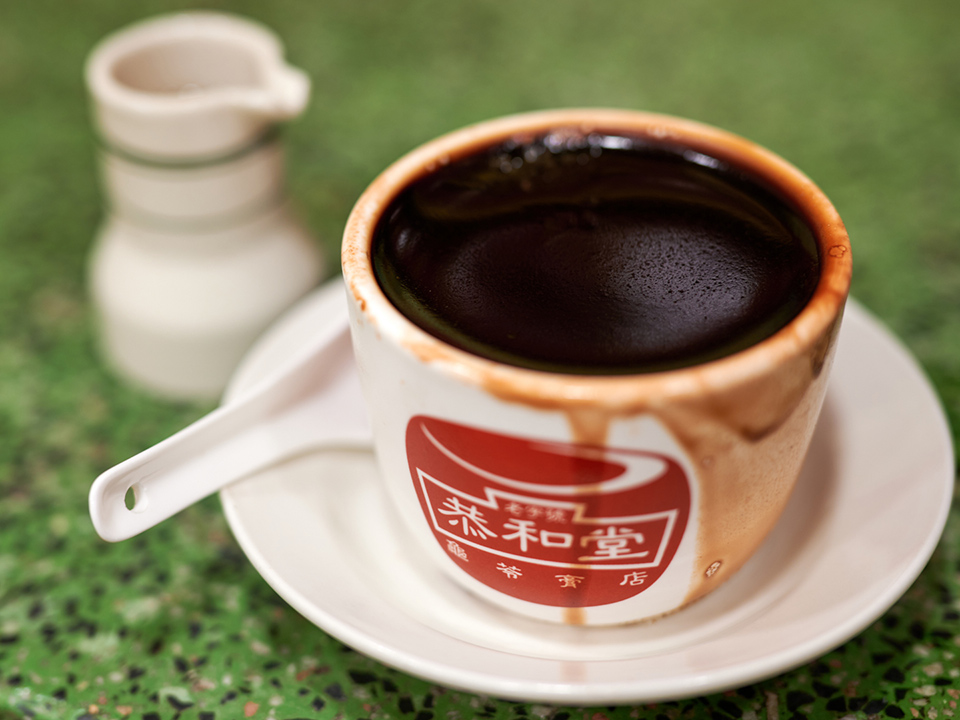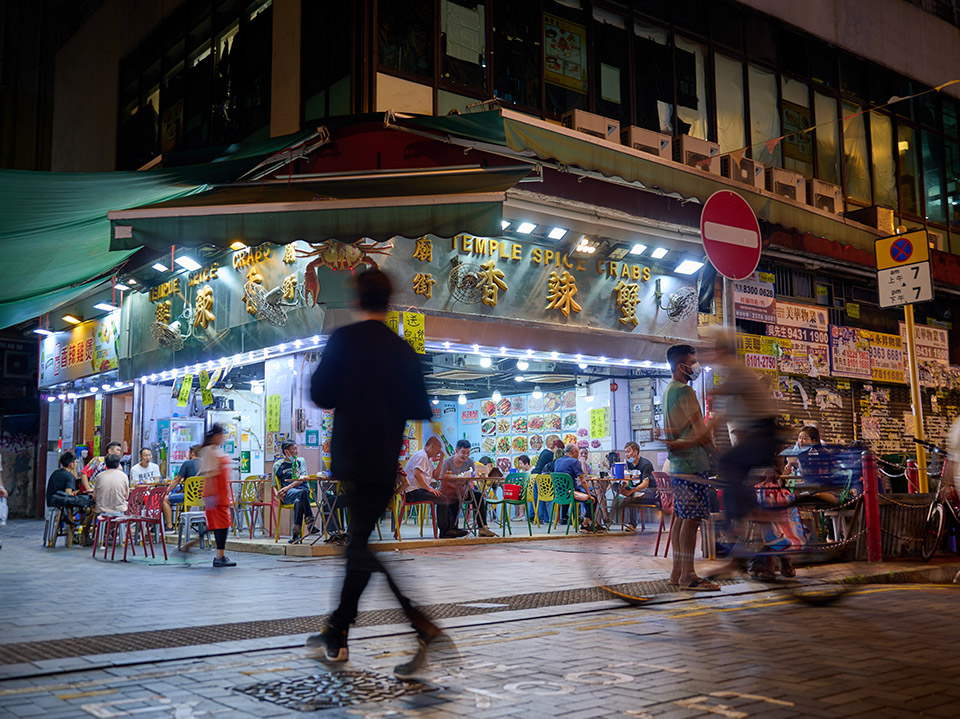
Feast your way through delicious local flavours
Start this walking tour at an unassuming shop a block away from the Yau Ma Tei Theatre. Even though you may not have directly heard of Kam Hing Noodles Food Company before, this noodle company is a bit of a Hong Kong institution to those in the know. Established in 1946, Kam Hing is a mainstay in this city’s thriving food and beverage business, supplying over 600 restaurants as well as world-renowned hotel chains in Hong Kong with their noodles. This third-generation family business, run by the Fung family father-and-son duo, now sells approximately 50 different varieties of noodles in-store, presented either freshly made or pre-packaged for ease of storage.

Make your way down Temple Street but don’t get too distracted by the knick-knack stalls of the market before turning into Woosung Street — you’re here for good food, and there is plenty of it to be found! Some of Hong Kong’s most interesting eateries are the food stalls provided with outside seating called dai pai dong (大排檔), where the set-up is little more than a stove, some fold-out tables, and a bunch of rickety stools.
The Woosung Street Temporary Cooked Food Hawker Bazaar is one such eatery, a famous neighbourhood site that used to be a stretch of approximately 20 dai pai dongs selling all kinds of meals and snacks. Despite the ‘temporary’ in its name, the hawker bazaar was opened back in 1984 and has been around for over 35 years! In 2021, the newly renovated hawker bazaar opened and is populated by some of the most beloved eateries in the area.

In Hong Kong, Traditional Chinese Medicine (TCM) is seen as a legitimate type of healing practice rooted in centuries of experience. One type of TCM remedy that is easiest on the first-timer’s palate is the guilinggao, also known as tortoise jelly, and Kung Wo Tong (恭和堂) is famous for it.
Despite its rather unappetising name, guilinggao does not contain the flesh of actual tortoises or turtles, and is mostly made of an assortment of herbs. It was inscribed onto the first national list of ICH in 2006, and is served either as a jelly with syrup, or in liquid form as a tea, and both types are considered great for detoxing and dispelling heatiness in the body, which usually accumulates after eating too many unhealthy foods.

If you’re usually inclined to liberally add spices to your cooking, then you will definitely love a visit to Kwong Fat Spices (廣發號). This spice store has remarkably been operating in Hong Kong for over a century, and has retained its old-school packaging and designs. This is where you can purchase Hong Kong-style curry pastes, chilli oils, and various types of peppers, to bring home a taste of the city’s famous cha chaan teng flavours.

Take a food detour into the cluster of streets between Jordan Road and Ferry Street known as Ferry Point (渡船角), so named because it used to be next to the old Jordan Road Ferry Pier. Our top tip here is to graze lightly at each stop as you stroll so you can try everything!
A must-visit is Tim Kee French Sandwiches, which has been selling freshly baked Vietnamese bánh mì since the 1970s. Stop by Sai Kwan Lo Jo for interesting Hong Kong fusion bites, and a cup of joe at Good Day Coffee.
Dessert Hero sells old-school desserts while Kactus Koffee serves a more modern selection, from blueberry cream cheese croffles to strawberry tiramisu. If baked goods are more your thing, then head on over to Good Neighbour Cake Shop (好鄰居餅店) for traditional Hong Kong Swiss rolls in a range of flavours.

Instead of just eating everything on the spot, you’ll want to bring home some reminders of your culinary tour. Liu Ma Kee Fermented Tofu Store (廖孖記), famous for making bean products using traditional methods following a closely guarded family recipe, has been selling their preserved bean curd to locals for over 100 years! Old-school packaging design is still being used on the glass jars holding their bean curd, and features an image of the founding Liu brothers.
Liu Ma Kee still uses a traditional stone mill to grind their soybeans, and their fermented tofu is particularly rich in flavour. Fermented tofu (腐乳) is considered an acquired taste by people unused to Chinese flavours, but it is widely appreciated by Hong Kong people local and abroad. It goes well with lamb, adding intense umami flavours to sauces and marinades, and even mixed with plain rice.

A piping hot bowl of noodles is a staple for locals young and old, perfect for any time of the day. A few streets over is Mak Man Kee Noodle Shop (麥文記麵家), a 60-year-old noodle shop that has truly risen through the ranks of the F&B world over the years. Founded back in 1958 as a humble dai pai dong food stall, Mak Man Kee’s speciality handmade wonton noodles have been recognised under the Michelin Bib Gourmand. Founder Mak Woon-chi brought these Cantonese noodles over to Hong Kong from Guangzhou, and sold them paired with handmade wontons.
Alternatively, you can always swing by the Kwun Chung Market and the Bowring Street Market — just a stone’s throw away — to continue your exploration of wok-fried Cantonese delights and souvenir shopping.

The simply named Mrs Fong Dessert (方太糕品舖) sells traditional, handmade Cantonese sweets and snacks that are getting increasingly harder to find, but are still worth tasting and remembering. The shop was Michelin Recommended in the 2022 guide for street food. This second-generation family business has no seating space, and has always been very popular among locals of all ages in the neighbourhood, so do expect to queue a little.
Look forward to a range of pudding-like cakes — not the fluffy cakes one would expect, but firmer versions with a springy texture that is best experienced for oneself. One of the confections that the shop is most famous for is its white sugar cake, which some have touted as one of Hong Kong’s best.

As the night falls, make your way back north to reach the final destination of this local flavours tour. There isn’t a more iconic or widely known night-time stomping ground in the city than the Temple Street Night Market, so head east two blocks over to join the midpoint of the market. This bustling, frenetic, and chaotic street has served as a filming location for many movies, and it’s not difficult to see why artists and directors are drawn to its visual energy. The street is also famous for its neon signs — look up to admire them in their multi-coloured glory set against the night sky. Stroll down the streets and alleys lined with restaurants and stalls displaying so much on offer that it might make your head spin. If you shop, don’t forget the cardinal rule: always haggle!


















































 Live Chat
Live Chat









